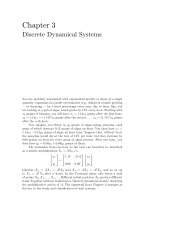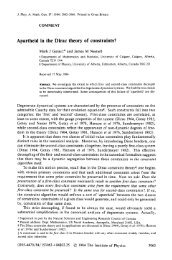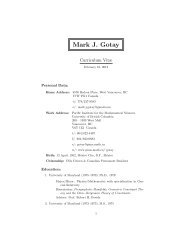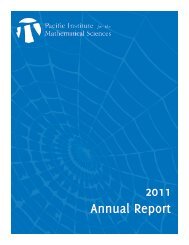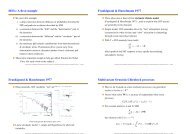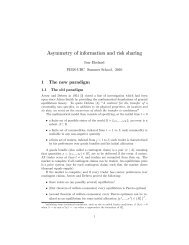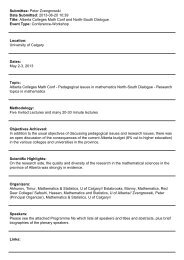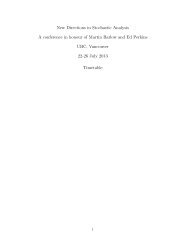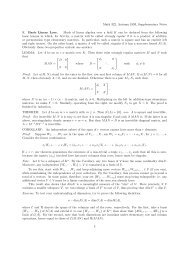33 PRIMA 2013 Abstractssense. Our approach does not involve invariant means forG.p-vari<strong>at</strong>ions of Fourier algebrasNico SpronkUniversity of W<strong>at</strong>erloo, Canadanspronk@uw<strong>at</strong>erloo.caLet G be a compact group and A(G) its Fourier algebra.About a half decade ago, an invesitg<strong>at</strong>ion of B. Forrest,E. Samei and the speaker brought up a curious Banachalgebra A ∆ (G) which plays a role rel<strong>at</strong>ive to oper<strong>at</strong>oramenability problems for A(G), in the same manner as acertain algebra A γ(G) of B. Johnson plays to amenabilityproblems. The algebra A γ(G) may be understoodas a type of “Beurling-Fourier algebra" on G, in a mannerwhich has been recently invesig<strong>at</strong>ed by H.H. Lee, E.Samei, J. Ludwig, L. Turowska and the speaker, in variousarticles.I will present a context in which we may understandA ∆ (G) as the case p = 2 in a class of Banach algebrasA p (G) (1 ≤ p ≤ ∞). Here A 1 (G) = A(G), but the rest ofthe algebras may be understood via interpol<strong>at</strong>ion. Thesealgebras do not exhibit the same functorial properties asFourier algebras, and hence allow us to exhibit some unusualBanach algebras on tori.This talk represents joint work with H.H. Lee and E.Samei.Zero products and norm preserving orthogonallyadditive homogeneous polynomials onC*-algebrasNgai-Ching WongN<strong>at</strong>ional Sun Y<strong>at</strong>-sen University, Taiwanwong@m<strong>at</strong>h.nsysu.edu.twLet P : A → B be a bounded orthogonally additiveand zero product preserving n-homogeneous polynomialbetween C*-algebras. We show th<strong>at</strong>, in the commut<strong>at</strong>ivecase th<strong>at</strong> A = C 0 (X) and B = C 0 (Y ), there exista bounded continuous function h in C(Y ) and a mapϕ : Y → X such th<strong>at</strong> P f = h · (f ◦ ϕ) n . In the generalcase, we show th<strong>at</strong> there is a central invertible multiplierh of B and a surjective Jordan homomorphism J : A → Bsuch th<strong>at</strong> P a = hJ(a) n , provided th<strong>at</strong> P (A) ⊇ B + . SimilarBanach-Stone type theorems also hold for orthogonallyadditive n-homogeneous polynomials which are n-isometries. Using these results, we provide the full structureof orthogonally additive and orthogonally multiplic<strong>at</strong>iveholomorphic functions on commut<strong>at</strong>ive C*-algebras.This is a joint work with Qingying Bu (Univ. of Mississippi)and Ming-Hsiu Hsu (N<strong>at</strong>’l Sun Y<strong>at</strong>-sen Univ.)Recent development of analysis on noncommut<strong>at</strong>ivetoriQuanhua XuWuhan University, China and University of Franche-Comté, FranceNoncommut<strong>at</strong>ive tori are fundamental examples in oper<strong>at</strong>oralgebras and noncommut<strong>at</strong>ive geometry. This talkwill present a survey on the recent development of analysison noncommut<strong>at</strong>ive tori. The results presented willinclude those on harmonic analysis and Sobolev embeddinginequalities on quantum tori. This talk is based onjoint works with Zeqian Chen, Xiao Xiong and Zhi Yin.Amenability properties of weighted group algebrasYong ZhangUniversity of Manitoba, Canadazhangy@cc.umanitoba.caLet G be a locally compact group and ω a continuousweight on G. It is well-known th<strong>at</strong> the weightedgroup algebra L 1 (G, ω) is amenable as a Banach algebraif and only if G is an amenable group and the functionΩ(t) = ω(t)ω(t −1 ) is bounded on G. We show th<strong>at</strong>, foran abelian locally compact group G, L 1 (G, ω) is weaklyamenable if and only if there is no nontrivial continuousgroup homomorphism φ: G → (C, +) such th<strong>at</strong>|φ(t)|supt∈G Ω(t) < ∞.In other words, Ω(t) shall grow slower then any φ in orderL 1 (G, ω) to be weakly amenable.We will also consider the weak amenability of L 1 (G, ω)and its center ZL 1 (G, ω) for non-commut<strong>at</strong>ive locallycompact groups G, discussing some special cases. In general,how to characterize the weak amenability of a noncommut<strong>at</strong>iveL 1 (G, ω) and how to characterize the weakamenability of its center algebra are still open problems.Special Session 17Optimiz<strong>at</strong>ionRegularized interior proximal altern<strong>at</strong>ing directionsmethodFelipe AlvarezUniversidad de Chile, Chilefalvarez@dim.uchile.clWe consider convex constrained optimiz<strong>at</strong>ion problemswith a special separable structure. We propose a class ofaltern<strong>at</strong>ing directions methods (ADM) where their subproblemsare regularized with a general interior proximalmetric which covers the double regulariz<strong>at</strong>ion proposed bySilva and Eckstein. Under standard assumptions, globalconvergence of the primal-dual sequences produced by thealgorithm is established.Linear conic programming and interior-pointalgorithmsYanqin BaiShanghai University, Chinayqbai@shu.edu.cnLinear conic programming extends the popularly used linearprogramming models from linearity to non-linearityas well as from convexity to non-convexity in polynomialtimecomput<strong>at</strong>ions. Linear conic programming problemsare linear programming models with the additional constraintof products of nonlinear cones which include twoclasses of important cones. One class is symmetric conewhich leads to symmetric cone optimiz<strong>at</strong>ion problemssuch as linear, semideąěnite and second-order cone programmingproblems in which the cone constraints are selfdualand homogeneous. These symmetric conic programmingcan be solved eąÀciently using polynomial-timeinterior-point methods. Another class is nonsymmetriccone optimiz<strong>at</strong>ion problems such as copositive cone programmingproblems and the cone programming of nonneg<strong>at</strong>ivequadr<strong>at</strong>ic function over a set. For these conicprogramming the cone constraints are not self-dual andin particular requires special purpose algorithm. The proposeof this talk is to introduce a very rich formul<strong>at</strong>ion oflinear conic programming and present the general model,the conjug<strong>at</strong>e duality theory, p<strong>at</strong>h-following interior pointapproaches and illustr<strong>at</strong>ive applic<strong>at</strong>ions of linear conicprogramming.
34 PRIMA 2013 AbstractsDesign of robust truss structures for minimumweight using the sequential convex approxim<strong>at</strong>ionmethodAlfredo CanelasUniversidad de la República, Uruguayacanelas@fing.edu.uyMiguel CarrascoUniversidad de los Andes, Chilemigucarr@uandes.clJulio LopezUniversidad Diego Portales, Chilejulio.lopez@udp.clTrusses are mechanical structures in R d , where d is 2 forplanar trusses or 3 for three-dimensional ones. They consistof an ensemble of N nodes joint by m ≥ 2 bars whichare made of a linear elastic, isotropic and homogeneousm<strong>at</strong>erial. Long bars overlapping small ones are not allowed,and therefore m ≤ N(N − 1)/2 for a mesh fullof bars. Trusses are designed to support some externalnodal loads taking into account the properties of the barm<strong>at</strong>erial. We assume th<strong>at</strong> there exists a set of primaryexternal loads, applied only in the nodes of the truss, andth<strong>at</strong> there exists a set of secondary nodal ones th<strong>at</strong> areuncertain in size and direction, which can be viewed asa perturb<strong>at</strong>ion of the main loads. Our main objective isto minimize the total amount of m<strong>at</strong>erial or weight, withthe purpose of finding the most economic structure, th<strong>at</strong>is robust under load perturb<strong>at</strong>ions.We formul<strong>at</strong>e a model in order to include the mechanicalequilibrium constraint and stress constraints, as well asbounds on displacements, considering also stability constraintsunder perturb<strong>at</strong>ion of the main load. More precisely,we will study the properties of the following non–convex semi-infinite m<strong>at</strong>hem<strong>at</strong>ical programming problem(P w) minx≥0m∑x ii=1|u j (ξ, x)| ≤ ū j j ∈ J ⊆ {1, . . . , n},|σ i (ξ, x)| ≤ ¯σ i i ∈ I ⊆ {1, . . . , m},ξ ∈ E,where x i represents the volume of each bar, u is the vectorof displacements, and σ i the stress of the i-th bar. Theset E ⊆ R n corresponds to the set of secondary loads,and we implicitly assume the mechanical equilibrium constraintK(x)u(ξ, x) = f + ξ. To address the infinite numberof constraints we reformul<strong>at</strong>e (P w) as a non–convexbilevel m<strong>at</strong>hem<strong>at</strong>ical program. The main idea is to solvethis problem assuming th<strong>at</strong> the set E of secondary loadstakes the form of a particular ellipsoid, similar to the approachedby Ben-Tal and Nemirovski . Based on the workof Beck et al., we have obtained encouraging preliminarynumerical results for this altern<strong>at</strong>ive, which approach consistson approxim<strong>at</strong>ing some non–convex constraints andsolving a sequence of parametric conic problems.Expected residual minimiz<strong>at</strong>ion for stochasticvari<strong>at</strong>ional inequalitiesXiaojun ChenThe Hong Kong Polytechnic University, Hong Kong,Chinamaxjchen@polyu.edu.hkThis talk discusses a variety of comput<strong>at</strong>ional approachesfor stochastic vari<strong>at</strong>ional inequalities and presents a newexpected residual minimiz<strong>at</strong>ion formul<strong>at</strong>ion for a classof stochastic vari<strong>at</strong>ional inequalities by using the gapfunction. The objective function of the expected residualminimiz<strong>at</strong>ion problem is nonneg<strong>at</strong>ive and Lipschitzcontinuous. Moreover, it is convex for some stochasticlinear vari<strong>at</strong>ional inequalities, which helps us guaranteethe existence of a solution and convergence of approxim<strong>at</strong>ionmethods. We propose a globally convergent(a.s.) smoothing sample average approxim<strong>at</strong>ion (SSAA)method to minimize the expected residual function. Weshow th<strong>at</strong> the residual minimiz<strong>at</strong>ion problem and itsSSAA problems have minimizers in a compact set andany cluster point of minimizers and st<strong>at</strong>ionary points ofthe SSAA problems is a minimizer and a st<strong>at</strong>ionary pointof the expected residual minimiz<strong>at</strong>ion problem (a.s.). Ourexamples come from applic<strong>at</strong>ions involving traffic flowproblems. We show th<strong>at</strong> the conditions we impose ares<strong>at</strong>isfied and th<strong>at</strong> the solutions, efficiently gener<strong>at</strong>ed bythe SSAA procedure, have desirable properties.Joint work with Roger Wets and Yangfan Zhang.Stability of two-stage stochastic programswith quadr<strong>at</strong>ic continuous recourseZhiping ChenXi’an Jiaotong Universityzchen@mail.xjtu.edu.cnYoupan HanXi’an Polytechnic UniversityWe consider the stability of the two-stage quadr<strong>at</strong>icstochastic programming problem with quadr<strong>at</strong>ic continuousrecourse when the underlying probability distributionis perturbed. For the case th<strong>at</strong> all the coefficientsin the objective function and the right-hand side vectorin second-stage constraints are random, we firstly showthe locally Lipschtiz continuity of the optimal value functionof the recourse problem; then under suitable probabilitymetric, we derive the Lipschitz continuity of theexpected optimal value function with respect to the firststagevariable and the probability distribution; and furthermore,we establish the qualit<strong>at</strong>ive and quantit<strong>at</strong>ivestability results of the optimal value function and theoptimal solution set with respect to the Fortet-Mourierprobability metric. For the more complex situ<strong>at</strong>ion th<strong>at</strong>the recourse costs, the recourse m<strong>at</strong>rix, the technologym<strong>at</strong>rix and the right-hand side vector in the second-stageproblem are all random, and th<strong>at</strong> the second-stage objectivefunction might be non-convex, we obtain the uniformlyboundedness and locally Lipschtiz continuity ofthe second-stage feasible solution set when it is regularand bounded; we also establish the locally Lipschtizcontinuity of the corresponding optimal value function;then we show the Lipschitz continuity of the expectedvalue function of the second-stage problem with respectto both the first-stage variables and the probability metricinvolved in the second-stage problem; utilizing theseresults, we finally derive the qualit<strong>at</strong>ive and quantit<strong>at</strong>ivestability results of the optimal value function andthe optimal solution set of two-stage quadr<strong>at</strong>ic stochasticprograms with respect to the Fortet-Mourier probabilitymetric.Existence of minimizers on dropsRafael CorreaUniversidad de Chile, Chilercorrea@dim.uchile.clFor a boundedly gener<strong>at</strong>ed drop [a, E] (property whichholds, for instance, whenever E is bounded), where abelongs to a real Banach space X and E ⊂ X is anonempty convex set, we show th<strong>at</strong> for every lower semicontinuousfunction h : X −→ R ∪ {+∞} th<strong>at</strong> s<strong>at</strong>isfiessup δ > 0 infx ∈ E + δBx h(x) > h(a)(B X being the unitaryopen ball in X), there exists x ∈ [a, E] such th<strong>at</strong>h(a) ≥ h(x) and x is a strict minimizer of h on the drop[x, E].The robust stability of every equilibrium ineconomic models of exchangeAlejandro JofreUniversity de Chile, Chileajofre@dim.uchile.cl
- Page 2 and 3:
1PRIMA 2013-Table of ContentsTable
- Page 4 and 5:
3PRIMA 2013-OrganizationOrganizatio
- Page 6 and 7:
5PRIMA 2013-OrganizationYoshikazu G
- Page 8 and 9:
7PRIMA 2013-Useful InformationUsefu
- Page 10 and 11:
9PRIMA 2013-Useful InformationTaxi:
- Page 12 and 13:
11PRIMA 2013-Useful Informationmath
- Page 14 and 15:
13PRIMA 2013 Program-Schedule-at-a-
- Page 16 and 17:
15PRIMA 2013 Program-Monday, June 2
- Page 18 and 19:
17PRIMA 2013 Program-Monday, June 2
- Page 20 and 21:
19PRIMA 2013 Program-Monday, June 2
- Page 22 and 23:
21PRIMA 2013 Program-Monday, June 2
- Page 24 and 25:
23PRIMA 2013 Program-Tuesday, June
- Page 26 and 27:
25PRIMA 2013 Program-Tuesday, June
- Page 29 and 30: 28PRIMA 2013 Program-Tuesday, June
- Page 31 and 32: 30PRIMA 2013 Program-Tuesday, June
- Page 33 and 34: 32PRIMA 2013 Program-Wednesday, Jun
- Page 35 and 36: 34PRIMA 2013 Program- Thursday, Jun
- Page 37 and 38: 36PRIMA 2013 Program- Thursday, Jun
- Page 39 and 40: 38PRIMA 2013 Program- Thursday, Jun
- Page 41 and 42: 40PRIMA 2013 Program- Thursday, Jun
- Page 43 and 44: 42PRIMA 2013 Program- Friday, June
- Page 45 and 46: 44PRIMA 2013 Program- Friday, June
- Page 48 and 49: 1 PRIMA 2013 AbstractsContents1 Pub
- Page 50 and 51: 3 PRIMA 2013 Abstractsof subfactors
- Page 52 and 53: 5 PRIMA 2013 AbstractsprocessesXu S
- Page 54 and 55: 7 PRIMA 2013 AbstractsIn this talk
- Page 56 and 57: 9 PRIMA 2013 Abstractsindependently
- Page 58 and 59: 11 PRIMA 2013 AbstractsEnumerating,
- Page 60 and 61: 13 PRIMA 2013 AbstractsRyuhei Uehar
- Page 62 and 63: 15 PRIMA 2013 AbstractsIn this talk
- Page 64 and 65: 17 PRIMA 2013 AbstractsSpecial Sess
- Page 66 and 67: 19 PRIMA 2013 Abstractscritical slo
- Page 68 and 69: 21 PRIMA 2013 AbstractsSpecial Sess
- Page 70 and 71: 23 PRIMA 2013 Abstractsstrictly awa
- Page 72 and 73: 25 PRIMA 2013 AbstractsPedram Hekma
- Page 74 and 75: 27 PRIMA 2013 Abstractsis well-know
- Page 76 and 77: 29 PRIMA 2013 Abstractssolid substr
- Page 78 and 79: 31 PRIMA 2013 AbstractsRapoport-Zin
- Page 82 and 83: 35 PRIMA 2013 AbstractsIn an econom
- Page 84 and 85: 37 PRIMA 2013 AbstractsKyoto Univer
- Page 86 and 87: 39 PRIMA 2013 AbstractsAlexander Mo
- Page 88 and 89: 41 PRIMA 2013 AbstractsOsamu SaekiK
- Page 90 and 91: 43 PRIMA 2013 Abstractsopen Delzant
- Page 92 and 93: 45 PRIMA 2013 AbstractsJian ZhouTsi
- Page 94 and 95: 47 PRIMA 2013 AbstractsJiaqun WeiNa
- Page 96 and 97: 49 PRIMA 2013 Abstractsthe end of 2
- Page 98 and 99: 51 PRIMA 2013 AbstractsJongyook Par
- Page 100 and 101: 53 PRIMA 2013 AbstractsPancyclicity
- Page 102 and 103: 55 PRIMA 2013 AbstractsEfficient nu
- Page 104 and 105: 57 PRIMA 2013 Abstractsand fountain
- Page 106: 59 PRIMA 2013 Abstractsformula esti



